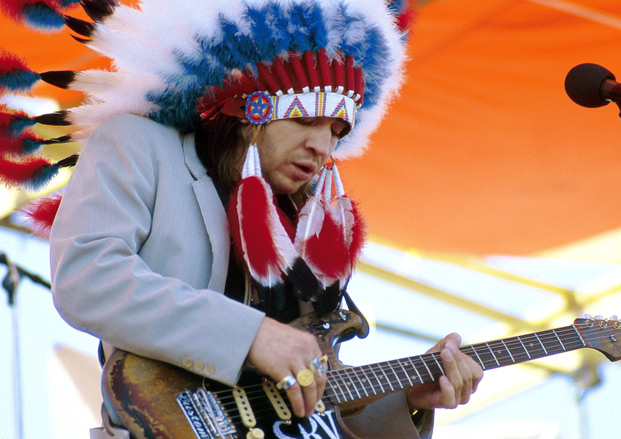How to Play Stevie Ray Vaughan's "Pride and Joy" Shuffle
Learn how to nail a complete blues shuffle, a lá Stevie Ray Vaughan's "Pride and Joy."

Stevie Ray Vaughan earned respect as a blues and rock player—a musician who could bridge the two worlds in a single solo.
As with all great guitarists, his rhythm playing was as strong as his leads. He excelled at a style of shuffle playing that has its roots in earlier players, yet he was able to turn it into a personal trademark.
This lesson is dedicated to Stevie's memory. When you listen to a rhythm section playing a medium shuffle, it's quite common to hear the bass playing a walking line (moving quarter notes) while the guitar strums chords on the upbeats. When these two parts are combined on one instrument, the result is a complete shuffle groove.
This is easy for a piano player, but on guitar, it''s a different story. One exception is the key of E, where open strings make all (well, many) things possible. This is the key Stevie Ray used for his Texas Flood recording of "Pride and Joy."
FIGURE 1, below, is similar to the main riff pattern in "Pride and Joy" and includes a combined bass line and chord part. Once you know the style, you can, like Stevie, throw in more licks and variations. The best way to master this pattern is to separate the bass line from the chords and work on each part individually. Here are a few things you need to know:
• Bass Line: Learn the bass part first, playing one note on each downbeat. You can play it using just your first and third fingers (fret hand). Rather than fretting the notes with your fingertips, use the sides or "paws" of the fingers, as this will enable you to mute idle strings by lightly touching them with the extended fingers, almost as if you were barring. Using all downstrokes, strum the strings with the pick as you would an acoustic guitar. If this fret-hand muting technique is done properly, you should be able to strike all six strings with the pick but hear only a single bass note.
• Chords: Just strum the top two open strings, no matter what chord you're on (that's the beauty of playing in E). Practice the feel of playing the chords by strumming only upstrokes on the upbeats. Choke the notes on the downbeats, letting your fingers flop back loosely onto the strings. Now put the whole thing together, bass notes on the downbeats, chords on the upbeats. Strum from the elbow and let your fret hand do all the muting work; stay loose and put your whole body into it. When you get the feel, you'll be surprised at how little effort it takes—just lay back and let Stevie Ray's spirit point you in the right direction.
All the latest guitar news, interviews, lessons, reviews, deals and more, direct to your inbox!


